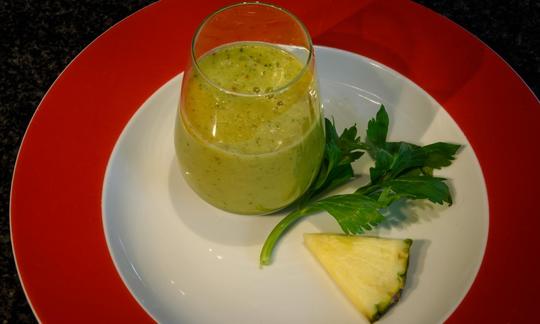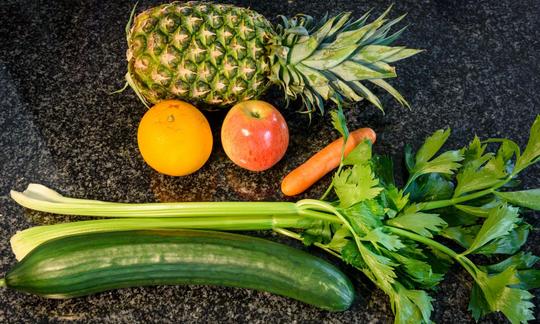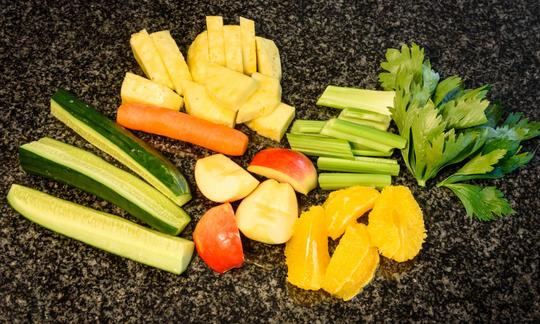Good morning smoothie with pineapple and celery
raw-vegan
Ingredients (for servings, )
| 2 stalks | Celery (bleached celery), raw (organic?) (2.1 oz) |
| 1 | Carrots (carrots), raw (organic?) (2.1 oz) |
| 1 | Oranges, raw (organic?) (4.6 oz) |
| ½ | Pineapple, raw (organic?) (16 oz) |
| 1 | Apple, raw, with peel (5.3 oz) |
| 1 | Cucumbers, raw (organic?) (16 oz) |
Equipment
- blender
- juicer
- vegetable peeler
Type of preparation
- chop or grind
- food preparation without heating
- blend
- juice
- peel
Preparation
Wash the celery and remove the strings. Wash the carrot and then juice it together with the celery in the juicer.
When using organic products, you do not have to peel them.
Peel the orange and pineapple and cut into pieces.
Wash the apple and cucumber and cut into pieces. Put them in a blender together with the orange, pineapple and the juice from the celery and carrot. Blend until you have a homogeneous smoothie.
Depending on the size of the ingredients used, you may need to add a little water or more cucumber or orange to give the final product the right consistency.
|
Nutritional Information per person
Convert per 100g
|
2000 kcal | |
|---|---|---|
| Energy | 235 kcal | 11.7% |
| Fat/Lipids | 0.85 g | 1.2% |
| Saturated Fats | 0.16 g | 0.8% |
| Carbohydrates (inc.dietary fiber) | 60 g | 22.2% |
| Sugars | 42 g | 46.5% |
| Fiber | 9.0 g | 36.1% |
| Protein/Albumin | 4.0 g | 8.0% |
| Cooking Salt (Na:52.6 mg) | 134 mg | 5.6% |
| Essential micronutrients with the highest proportions | per person | 2000 kcal | |
|---|---|---|---|
| Vit | Vitamin C (ascorbic acid) | 156 mg | 194.0% |
| Min | Manganese, Mn | 2.4 mg | 120.0% |
| Vit | Vitamin K | 54 µg | 71.0% |
| Elem | Potassium, K | 958 mg | 48.0% |
| Vit | Folate, as the active form of folic acid (née vitamin B9 and | 95 µg | 48.0% |
| Min | Copper, Cu | 0.42 mg | 42.0% |
| Vit | Vitamin A, as RAE | 289 µg | 36.0% |
| Vit | Vitamin B6 (pyridoxine) | 0.48 mg | 34.0% |
| Vit | Thiamine (vitamin B1) | 0.34 mg | 31.0% |
| Vit | Pantothenic acid (vitamin B5) | 1.4 mg | 24.0% |
Detailed Nutritional Information per Person for this Recipe
The majority of the nutritional information comes from the USDA (US Department of Agriculture). This means that the information for natural products is often incomplete or only given within broader categories, whereas in most cases products made from these have more complete information displayed.
If we take flaxseed, for example, the important essential amino acid ALA (omega-3) is only included in an overarching category whereas for flaxseed oil ALA is listed specifically. In time, we will be able to change this, but it will require a lot of work. An “i” appears behind ingredients that have been adjusted and an explanation appears when you hover over this symbol.
For Erb Muesli, the original calculations resulted in 48 % of the daily requirement of ALA — but with the correction, we see that the muesli actually covers >100 % of the necessary recommendation for the omega-3 fatty acid ALA. Our goal is to eventually be able to compare the nutritional value of our recipes with those that are used in conventional western lifestyles.
| Essential fatty acids | per person | 2000 kcal |
|---|---|---|
| Alpha-Linolenic acid; ALA; 18:3 omega-3 | 0.06 g | 3.0% |
| Linoleic acid; LA; 18:2 omega-6 | 0.22 g | 2.0% |
| Essential amino acids | per person | 2000 kcal |
|---|---|---|
| Threonine (Thr, T) | 0.16 g | 18.0% |
| Tryptophan (Trp, W) | 0.04 g | 15.0% |
| Isoleucine (Ile, I) | 0.14 g | 11.0% |
| Lysine (Lys, K) | 0.20 g | 11.0% |
| Valine (Val, V) | 0.17 g | 10.0% |
| Phenylalanine (Phe, F) | 0.14 g | 9.0% |
| Leucine (Leu, L) | 0.19 g | 8.0% |
| Methionine (Met, M) | 0.06 g | 7.0% |
| Vitamins | per person | 2000 kcal |
|---|---|---|
| Vitamin C (ascorbic acid) | 156 mg | 194.0% |
| Vitamin K | 54 µg | 71.0% |
| Folate, as the active form of folic acid (née vitamin B9 and | 95 µg | 48.0% |
| Vitamin A, as RAE | 289 µg | 36.0% |
| Vitamin B6 (pyridoxine) | 0.48 mg | 34.0% |
| Thiamine (vitamin B1) | 0.34 mg | 31.0% |
| Pantothenic acid (vitamin B5) | 1.4 mg | 24.0% |
| Riboflavin (vitamin B2) | 0.23 mg | 16.0% |
| Niacin (née vitamin B3) | 2.0 mg | 13.0% |
| Biotin (ex vitamin B7, H) | 6.6 µg | 13.0% |
| Vitamin E, as a-TEs | 0.65 mg | 5.0% |
| Essential macroelements (macronutrients) | per person | 2000 kcal |
|---|---|---|
| Potassium, K | 958 mg | 48.0% |
| Magnesium, Mg | 74 mg | 20.0% |
| Calcium, Ca | 119 mg | 15.0% |
| Phosphorus, P | 108 mg | 15.0% |
| Sodium, Na | 53 mg | 7.0% |
| Essential trace elements (micronutrients) | per person | 2000 kcal |
|---|---|---|
| Manganese, Mn | 2.4 mg | 120.0% |
| Copper, Cu | 0.42 mg | 42.0% |
| Iron, Fe | 1.6 mg | 11.0% |
| Zinc, Zn | 0.92 mg | 9.0% |
| Selenium, Se | 1.4 µg | 3.0% |
| Iod, I (Jod, J) | 2.1 µg | 1.0% |
| Fluorine, F | 7.6 µg | < 0.1% |
This morning smoothie with pineapple and celery is pleasantly fruity and light, making it ideal for a refreshing start to the day.
Celery: Celery, also known as celery sticks, is a variety of real celery. It has a mild taste of celery, but its high water content gives it a fresh, juicy and crunchy consistency. Thanks to its water content, it is one of the lowest-calorie vegetables. Its typical smell is due to the high content of essential oils, which are found in all of its plant organs in so-called oil ducts. Celery also contains antioxidant vitamins such as vitamin C or beta-carotene and many polyphenols (secondary plant substances), which slow down or completely prevent oxidation processes.
Pineapple and bromelain : Ripe pineapple has a fruity, sweet taste with a slightly sour note and is very juicy. Pineapple is also rich in vitamins (especially vitamin C) and contains a variety of minerals and enzymes. With regard to the latter, two enzymes from the cysteine protease family that have been discovered in pineapple are particularly interesting. This is known as bromelain (or sometimes bromelin). Bromelain breaks down proteins in the body and in animal foods. On the one hand, it serves as a tenderizer for meat, but on the other hand it also causes dairy products to taste unpleasantly bitter when combined with pineapple. In preclinical and pharmacological studies, bromelain also showed wound-healing and anti-metastatic effects.
Difference between juice and smoothie: While juicing produces a liquid juice, a smoothie is more like a puree. In contrast to juice, smoothies use the whole fruit, sometimes the peel too. The basis of smoothies is therefore fruit pulp or fruit puree, which can be diluted depending on the recipe to achieve a creamy consistency.
From a nutritional point of view, smoothies have the advantage over juices that no ingredients are lost. When you drink a smoothie, you drink the fiber as well. Fiber is very important for intestinal health. It also ensures that the sugar from the fruit enters the metabolism more slowly and gently than with juice freshly squeezed from a juicer. This means that you feel fuller after drinking a smoothie for longer than with juice. This smoothie is actually a combination of juice and smoothie.
Celery leaves: Celery leaves contain a lot of apiin (a chemical compound from the group of flavone glycosides), which is also found in parsley. This, along with other essential oils, gives the vegetable its typical spicy taste. We therefore recommend using the leaves, either whole for cooking or finely chopped as a spice.
Storing celery: Celery will last up to two weeks when stored in the refrigerator. It is important to ensure that it is stored separately from ripe apples, tomatoes or avocados. These fruits produce the ripening gas ethylene, which reduces the shelf life of the celery. Celery stalks that bend are over-aged.
Consistency: If you prefer a more liquid drink, you can either increase the amount of cucumber or orange, or juice other or all of the ingredients instead of putting them in the blender. By reading the text listed in the instructions (difference between juice and smoothie) you can weigh up the pros and cons between smoothie and juice. We found this interesting compromise to be the best combination in the test, although you have to clean two machines afterwards.
Use the pulp: Instead of throwing the pulp away, you can incorporate it into vegan muesli combinations or vegetable salads, for example. It is also a good ingredient for soups, but you should add other vegetables, as the pulp has a much reduced flavor depending on the juicer.








